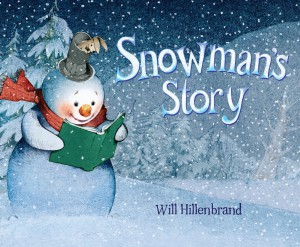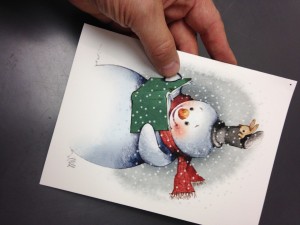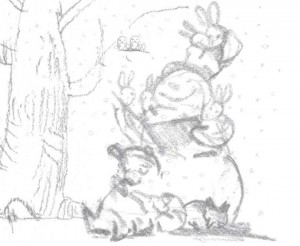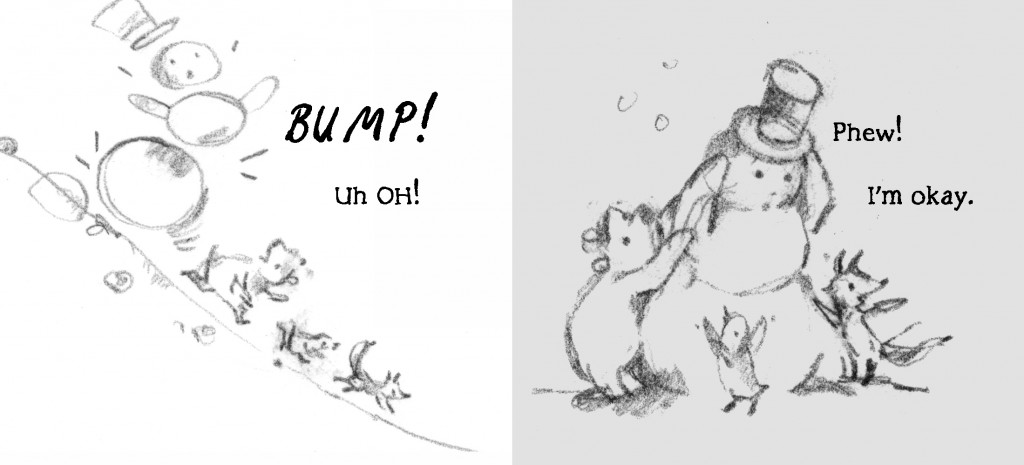 Will Hillenbrand has illustrated many beloved picture books, including “Kiss the Cow,” by Phyllis Root; and “Sleep, Big Bear, Sleep!” and “Sneeze, Big Bear, Sneeze!” by Maureen Wright. He has also written and illustrated a number of picture books, including “Down by the Barn,” the “Bear and Mole” series, and “Mother Goose Picture Puzzles.” The following is a complete transcript of his interview with Cracking the Cover for his new book, “Snowman’s Story.”
Will Hillenbrand has illustrated many beloved picture books, including “Kiss the Cow,” by Phyllis Root; and “Sleep, Big Bear, Sleep!” and “Sneeze, Big Bear, Sneeze!” by Maureen Wright. He has also written and illustrated a number of picture books, including “Down by the Barn,” the “Bear and Mole” series, and “Mother Goose Picture Puzzles.” The following is a complete transcript of his interview with Cracking the Cover for his new book, “Snowman’s Story.”
Have you always wanted to be an illustrator?
I couldn’t have always wanted to be an illustrator because I didn’t know the job “illustrator” ever existed as a child. I thought books were made by machines! Without having an artist in my life I could only imagine that the all-powerful machine could make such beautiful pictures. Boy, was I happy I was wrong; machines couldn’t or wouldn’t ever be able to convey human emotions the way an illustrator can.
Sometimes you work in conjunction with other authors, other times you are both author and illustrator. How do the two situations differ? Is one harder than the other?
I see my work as play. If I’m not enjoying my play, I don’t think my readers will enjoy my books. Of course, there are times when making my books can be frustrating but I work through that. Frustration is a natural part of the creative process. It’s important to remember that we should never end a project due to frustration. We should work through it just as the heroes do in the best books.
I have been extremely fortunate to have worked with wonderful, extraordinary and brilliant authors . . . one of whom is my wife, Jane. I simply treasure each and every one of those people who put their pencils to paper and write magic. The only difference I see when I am the author and illustrator of a book is that it is a direct vision into my personal imagination.
 Where do your ideas come from?
Where do your ideas come from?
I am fortunate to have a very vivid imagination. I think in pictures; images always come first. I simply need to draw them so that readers may see what I see. I love a good story. Nothing beats a good story well told.
Specifically, where did the idea for “Snowman’s Story” come from?
First of all, you should know that I love snow. You should also know that every holiday season I create an image that is used for my holiday cards which are sent to my friends and family. Before I begin, I try to imagine what it would be like to see the faces of my loved ones opening their cards. That always puts a smile on my face because I hope to do the same for them.
Three or four years ago I was wondering what image I should create. One of the ingredients I like to include in my illustrated cards is a book with someone reading it (the word illustration means to “lighten up” or to enlighten). I decided to draw a snowman reading a book. Since it looked like a good story, someone HAD to be listening . . . in this case, a rabbit in the snowman’s hat! I added color to the art which made the book glow and that in turn illuminated the snowman’s face. Sometime after the holiday season Margery Cuyler, my editor and recipient of one of the cards, suggested that I create a book inspired by the image on the holiday card.
 Regarding the story creation, that idea stemmed from my personal experience. As a child I had once heard a story that I thought was so amazing that I borrowed the book from my public library with full intention of never ever returning it. Being the silly boy that I was, I hid the book in my house . . . again and again and again. When the late return notices came I panicked and looked in each and every one of my hiding places but I had forgotten where I had hidden the book! The book, The Red Balloon, was never found. We paid the fine for the book and I decided never to run off with a book again. That is, until I made this book when Rabbit becomes a book thief. I know why he did it; he wanted to share a great story. By the way, Rabbit does return the book to Snowman because it tells that story so very well, the best.
Regarding the story creation, that idea stemmed from my personal experience. As a child I had once heard a story that I thought was so amazing that I borrowed the book from my public library with full intention of never ever returning it. Being the silly boy that I was, I hid the book in my house . . . again and again and again. When the late return notices came I panicked and looked in each and every one of my hiding places but I had forgotten where I had hidden the book! The book, The Red Balloon, was never found. We paid the fine for the book and I decided never to run off with a book again. That is, until I made this book when Rabbit becomes a book thief. I know why he did it; he wanted to share a great story. By the way, Rabbit does return the book to Snowman because it tells that story so very well, the best.
“Snowman’s Story” features no text. Where did that decision come from? Did it make it more difficult to convey the story you wanted to tell?
I had a written story in the first several book dummies but with each revision more words were tossed out because the pictures were telling the story. Suddenly, I realized all the words were —gone! I thought, “Oh, okay, this is the kind of book you want to be.” Making a wordless book was different and challenging because of the obvious reasons. This kind of story telling needs to be told in the most pure language, the international language of pictures.
 As an illustrator, how has your work evolved over the years?
As an illustrator, how has your work evolved over the years?
My work as an illustrator and author continues to evolve. I always create images with all of the integrity that I have; as a creative person I allow myself to be open . . . open and vulnerable and sensitive and strong. But I put my face to the wind and discover the visual world that seem to be just right to me. Every creative person already knows this. I have often seen this best represented in the non-intentional art of children.
Something that has not changed but has become stronger inside me is my devotion and love for my readers
Why do you think children are drawn to your work?
Children may be drawn to my work because of my characters. I try to convey to them what is both real and magical and kind and a little mischievous.
Is there a particular book from your own childhood that still resonates with you?
Many books do but today I’ll pick just one—The Tale of Peter Rabbit. I love that story because my grandmother read it aloud to me, and I love it and I knew she loved me, she read to me! Hugs and kisses to Grandma, read it again . . . please.

